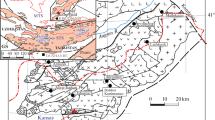Abstract
Element geochemistry of gold and arsenic and mineralogical features of their sulfides in the Carlin-type gold deposits of the Qinling region are discussed in this paper. The initial contents of ore-forming elements such as gold and arsenic are high in the ore-bearing rock series in the Qinling region. Furthermore, both the metals are concentrated mainly in the diagenetic pyrite. Study on the mineralogy of arsenic-bearing sulfide minerals in the ores demonstrated that there is a positive correlation between gold and arsenic in the sulfide minerals. Available evidence suggests that gold in the As-bearing sulfide minerals is likely to be presented as a charge species (Au+), and it is most possible for it to replace the excess arsenic at the site of iron and was probably deposited together with arsenic as solid solution in the sulfide minerals. Pyrite is composed of (Au 3+x , Fe 2+1−x ) ([AsS] 3−x [S2] 2−1−x , and arsenopyrite of (Au 3+x , Fe 3+1−x ) ([AsS] 3−x [AsS2] 3−1−x ). The occurrence of gold in the As-sulfide minerals from the Carlin-type gold deposits in the Qinling region has been confirmed by electron probe and transmission electron microscopic studies. The results show that gold was probably deposited together with arsenic as coupled solid solutions in sulfide minerals in the early stage of mineralization. Metallogenic chemical reactions concerning gold deposition in the Carlin-type As-rich gold deposits would involve oxidation of gold and concurrent reduction of arsenic. Later, the deposited gold as solid solution was remobilized and redistributed as exsolutions, as a result of increasing hydrothermal alteration and crystallization, and decreasing resistance to refractoriness of the host minerals. Gold occurs as sub-microscopic grains (ranging from 0.04 to 0.16 μm in diameter) of native gold along micro factures in and crystalline grains of the sulfides.
Similar content being viewed by others
References
Arehart, G.B. and S. L. Chryssoulis, 1993, Gold and arsenic in iron sulfides from sediment-hosted disseminated gold deposits: Implications for depositional processes, Nevada: Econ. Geol., v.88, p.171–185.
Bokken, B.M., R.H. Brigham, and R. H. Flemng, 1991, The distribution of gold in unpxidized ore from the Carlin-type deposits revealed by secondary ion mass spectrometry (SIMS): Geol. Am., v. 23, p.228–305.
Calnakova, N.N. and B. O. Manichalachin, 1990, Physicochemical conditions for the formation of antimony and antimony-gold mineralization: Geochemistry, v. 12, p.1756–1765 (in Russian).
Chryssoulis, S. L., N. S. Mcintyre, and J. R. Mycroft, 1993, Determination of gold in natural sulfide minerals using X-ray photo-electron spectroscopy: Can. Mineral., v.31, p.231–240.
Cook, N.J., 1991, The contents of “invisible” gold in common sulfides: Translated Papers of Geological Science, v.8, n.4, p.5–13 (Chinese version).
Korpakova, N.N., 1990, v.12, p. 1756–1765 (in Russian).
Mumin, A. H., M.E. Fleet, and S.L. Chryssoulis, 1994, Gold mineralization in As-rich mesothermal gold ores of the Gogosu-Prestea mining district of the Ahsanti Gold Belt, Ghana: Remobilization of “invisible” gold: Mineral Deposita, v. 29, p. 445–460.
Spycher, N. F. and M. H. Reed, 1989, Ab (DI) sulfide complexes: Au evaluation of stoichiometry and stability from existing experimental data: Geochim. et Cosmochim. Acta, v.53, 2185–2194.
Wang Kuiren and Ren Zhigang, 1992, Ion microprobe and scanning electron microscopic investigations of the occurring forms of micro-fine gold in gold deposits of Guangxi: Chinese Science Bulletin, v.9, p. 832–835 (in Chinese).
Zhang Fuxin, 1984, The evolution and origin of pyrite in the Ertaizi gold deposit of Shaanxi: Minerals and Rocks, v.4, n. 1, p. 22–28 (in Chinese with English abstract).
Zhang Fuxin, Liu Wentao, and Wei Kuanyi, 1993, Characteristics and evolution of auriferous pyrite in the Jinlongshan-Qiuling gold deposits in the Ding-Ma ore belt of Shaanxi Province: Geology and Exploration, v. 29, n. 10, p. 27–33 (in Chinese with English abstract).
Author information
Authors and Affiliations
Additional information
Granted jointly by the Armed Police Headquarters (No. Au 5-1-1991) and the Special Funds for the Key Projects sponsored by the Shaanxi Provincial Education Committee.
Rights and permissions
About this article
Cite this article
Zhang, F., Ma, J. & Chen, Y. Geochemical study of gold and arsenic mineralization of the carlin-type gold deposits, Qinling Region, China. Chin. J. of Geochem. 20, 333 (2001). https://doi.org/10.1007/BF03166858
DOI: https://doi.org/10.1007/BF03166858




